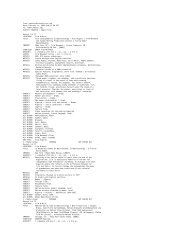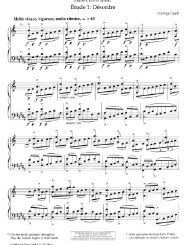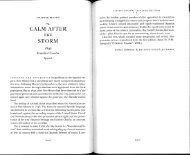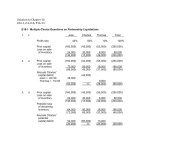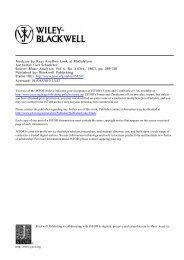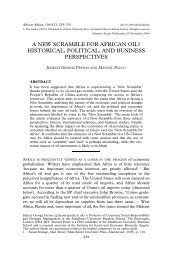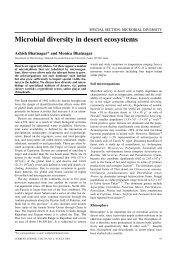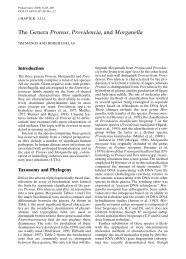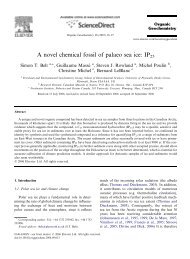The Genus Serratia
The Genus Serratia
The Genus Serratia
Create successful ePaper yourself
Turn your PDF publications into a flip-book with our unique Google optimized e-Paper software.
232 F. Grimont and P.A.D. Grimont CHAPTER 3.3.11<br />
Gas Production<br />
Gas production differentiates <strong>Serratia</strong> marcescens<br />
from S. liquefaciens—S. proteamaculans<br />
better when glucose agar is used than when a<br />
liquid medium with a Durham inverted tube is<br />
used (Grimont et al., 1977b). Glucose agar consists<br />
of nutrient agar (meat extract [Liebig], 3 g;<br />
yeast extract [Difco], 10 g; agar [BBL], 15 g; distilled<br />
water to 1 liter; pH 7.4) supplemented with<br />
1% (wt/vol) glucose. Dispense into tubes (160 ×<br />
10 mm). Autoclave 20 min at 120°C, cool at 50°C,<br />
and inoculate before the agar sets. Tubes are<br />
examined for bubbles of gas for up to 3 days.<br />
β-Xylosidase<br />
<strong>The</strong> method of Brisou et al. (1972) for demonstrating<br />
β-xylosidase can conveniently be<br />
adapted for use with sterile microculture plates.<br />
Aqueous (1% wt/vol) p-nitrophenyl-β-xyloside<br />
is dispensed into the wells in 0.05-ml amounts,<br />
followed by 0.05 ml of a fresh bacterial suspension<br />
in 0.25 M phosphate buffer, pH 7. Plates are<br />
examined for a yellow color after 24 h.<br />
Identification of <strong>Serratia</strong> at the <strong>Genus</strong> Level<br />
Members of the genus <strong>Serratia</strong> share the characteristics<br />
defining the family Enterobacteriaceae.<br />
Only occasionally can a nitrate-negative strain<br />
be isolated. <strong>The</strong> properties that best define the<br />
genus <strong>Serratia</strong> are listed in Table 3. Although<br />
lipase activity on tributyrin or corn oil is listed,<br />
S. odorifera strains are only weakly lipolytic. A<br />
weak urease activity, lack of motility, or presence<br />
of a capsule are occasionally observed. <strong>Serratia</strong>e<br />
are clearly differentiated from Klebsiella spp.,<br />
Enterobacter aerogenes, and E. cloacae by production<br />
of gelatinase, lipase, DNase, and by<br />
growth on caprate or caprylate as sole carbon<br />
source. Some soft-rot Erwinia spp. produce<br />
extracellular proteinase and DNase, but these<br />
strains are pectinolytic and lack glucose and gluconate<br />
dehydrogenases (Grimont et al., 1977b).<br />
Identification of <strong>Serratia</strong> Species<br />
<strong>The</strong> characteristics best allowing identification of<br />
each <strong>Serratia</strong> species are given in Tables 4 and 5.<br />
Carbon source utilization tests are invaluable for<br />
unambiguous identification. Indole production<br />
by S. odorifera is not reproducibly observed<br />
when peptone water is used. A defined medium<br />
containing trytophane (e.g., “urée-indole”<br />
medium, Diagnostics Pasteur, Marnes-la-<br />
Coquette, France; or the indole test in API 20E<br />
strips) gives consistently positive results with this<br />
species. With the use of classical tests (Ewing,<br />
1986), S. plymuthica may be confused either with<br />
Table 3. Characteristics defining the genus <strong>Serratia</strong>. a<br />
Positive characteristics of all species of the genus <strong>Serratia</strong> b<br />
Motile rods<br />
Growth at 20°C in 1 day<br />
Growth at pH 9<br />
Growth with 4% NaCl<br />
Growth on minimal medium without addition of growth<br />
factor<br />
Acid from maltose<br />
Acid from mannitol<br />
Acid from salicin<br />
Acid from trehalose<br />
ONPG c hydrolyzed<br />
Glucose oxidized to gluconate d<br />
Gluconate oxidized to 2-ketogluconate<br />
Carbon source utilization tests: N-acetylglucosamine, cisaconitate,<br />
4-aminobutyrate, citrate, fructose, galactose,<br />
galacturonate, gluconate, glucose, glucuronate, glycerol,<br />
m-inositol, 2-ketogluconate, L-malate, maltose, mannitol,<br />
mannose, putrescine, ribose, trehalose<br />
Additional positive characteristics of <strong>Serratia</strong> species other<br />
than S. fonticola b<br />
Voges-Proskauer test (Richard)<br />
Lipase (tributyrin, corn oil)<br />
Growth on caprylate-thallous agar<br />
DNase<br />
Proteinase(s)<br />
Negative characteristics of all species of the genus <strong>Serratia</strong> b<br />
Urease (Ferguson)<br />
H2S from thiosulfate<br />
Phenylalanine/tryptophane deaminase<br />
Polygalacturonidase<br />
Amylase (4-day reading)<br />
β-Glucuronidase<br />
Carbon source utilization tests: 5-aminovalerate, mcoumarate,<br />
ethanolamine, glutarate, histamine, L-sorbose,<br />
tryptamine<br />
Sodium ion requirement<br />
Anaerobic growth with KClO3<br />
Additional negative characteristics of <strong>Serratia</strong> species other<br />
than S. fonticola<br />
Acid from dulcitol<br />
Carbon source utilization tests: dulcitol, 3-phenylpropionate<br />
a<br />
Taken from Grimont et al., 1977b, and unpublished<br />
observations.<br />
b<br />
More than 90% of the isolates of each species give the same<br />
reaction.<br />
c<br />
ONPG, ortho-nitrophenyl-galactoside.<br />
In the presence of pyrroloquinoline quinone.<br />
S. proteamaculans, S. liquefaciens, S. rubidaea,<br />
or Enterobacter agglomerans. In the past, S.<br />
plymuthica had been identified as “atypical S.<br />
liquefaciens” (negative for lysine and ornithine<br />
decarboxylase) or atypical S. rubidaea (sorbitol<br />
positive). <strong>The</strong> species S. odorifera can also be<br />
recognized in a number of “rhamnose-positive S.<br />
liquefaciens” strains. Carbon source utilization



